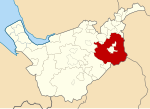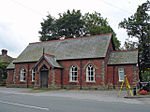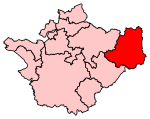Adlington Hall is a country house near Adlington, Cheshire. The oldest part of the existing building, the Great Hall, was constructed between 1480 and 1505; the east wing was added in 1581. The Legh family has lived in the hall and in previous buildings on the same site since the early 14th century. After the house was occupied by Parliamentary forces during the Civil War, changes were made to the north wing, including encasing the Great Hall in brick, inserting windows, and installing an organ in the Great Hall. In the 18th century the house was inherited by Charles Legh who organised a series of major changes. These included building a new west wing, which incorporated a ballroom, and a south wing with a large portico. It is possible that Charles Legh himself was the architect for these additions. He also played a large part in planning and designing the gardens, woodland and parkland, which included a number of buildings of various types, including a bridge known as the Chinese Bridge that carried a summerhouse.
The hall was reconstructed and reduced in size in 1928. The work included demolition of much of the west wing, building a screen wall to fill the gap, and removing parts of the south wing. During the 19th and early 20th centuries the gardens, parkland and woodland became overgrown, and the condition of some of the buildings in them deteriorated. From the middle of the 20th century, work has been undertaken to restore some of the parkland and its buildings, and to create new formal gardens near the hall.
Adlington Hall is recorded in the National Heritage List for England as a designated Grade I listed building. The stable block has been converted for modern uses; part of it is listed at Grade II*, and the rest is at Grade II. The grounds contain eleven Grade II listed buildings, and the grounds themselves have been designated at Grade II* on the National Register of Historic Parks and Gardens. The hall is open to the public for visits and guided tours, and parts of the building can be hired for weddings and social functions.










